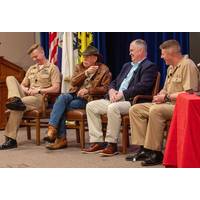
NUWC Division Newport Hosts Warfighters Panel, ‘Cup O’ Joe’ to Celebrate Veterans
United by their service as U.S. Navy submariners, four men spanning decades in age came together at the Naval Undersea Warfare Center (NUWC) Division Newport on Nov. 13. Spearheaded by Commanding Officer Capt. Kevin Behm and moderated by Deputy Technical Director Steve O’Grady, the command hosted “Passing the Watch: Submarine Generations” to celebrate veterans before an engaged audience in Chafee Auditorium.Staged as a talk show with O’Grady serving as the host, the warfighters panel included Behm, retired Lt. Ronald Renner, retired Cmdr. David Kelly and active-duty Sailor
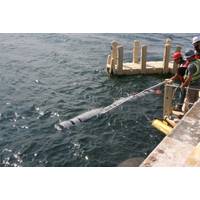
REMUS 620 Conducts First Torpedo Tube Recovery and Swimout
A joint team from HII, Woods Hole Oceanographic Institution (WHOI), and the U.S. Navy’s Naval Undersea Warfare Center Division Newport (NUWC Division Newport) has successfully completed the first recovery of a second-generation REMUS 620 into a Virginia-class submarine torpedo tube and shutterway test fixture at Seneca Lake, New York.The project, completed less than seven months after integrating WHOI’s Yellow Moray torpedo tube launch and recovery (TTL&R) technology into the next-generation REMUS 620 medium unmanned undersea vehicle (UUV), marks a step forward in the U.S. Navy Submarine

NUWC Division Newport Shares Strategic Vision at Defense Innovation Days
Naval Undersea Warfare Center (NUWC) Division Newport Technical Director Marie Bussiere unveiled the command’s 10-year strategic vision and outlined industry’s role in that initiative during a panel discussion at Southeastern New England Defense Industry Alliance (SENEDIA) Defense Innovation Days held Aug. 25-27 at the Newport Marriott. The strategic vision, “Mastery of the Seas at All Depths 2035,” aims to expand the battlespace from the seabed to space, drive the integration of technology, and strengthen partnerships with industry to accelerate the delivery of systems
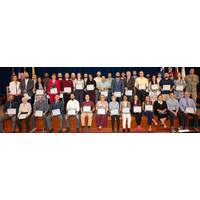
Navy’s NUWC Newport Honors 42 Training Program Graduates
The U.S. Navy’s Naval Undersea Warfare Center (NUWC) Division Newport has honored 42 students who completed its Academic Degree Training Program (ADTP), earning degrees in engineering, cybersecurity and other technical fields.Since the inception of ADTP in 2018, Division Newport has seen a total of 315 graduates in the program which offers financial and other support.ADTP includes a Fellowship Program, Part-time Academic Training Program (PTADTP), and Naval Postgraduate School attendance.The numerous degrees and certificate programs provide professional education and development, that has
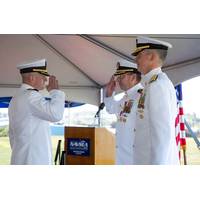
NUWC Division Newport Hosts Change of Command
Capt. Kevin J. Behm became the 72nd commanding officer of the Naval Undersea Warfare Center (NUWC) Division Newport as he relived Capt. Chad F. Hennings during a change of command ceremony held on Sept. 3. Behm, a 2004 graduate of the U.S. Naval Academy, most recently served as the commanding officer of the USS Hartford (SSN 768). His previous submarine tours include the USS Oklahoma City (SSN 723), USS Georgia (SSGN 720), USS Florida (SSGN 728) and USS New Hampshire (SSN 778). Ashore, he served as shift engineer at the Nuclear Power Training Unit, junior board member on the Pacific Fleet
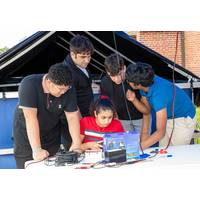
NUWC Division Newport’s Summer STEM Program Encourages Career Exploration
The Naval Undersea Warfare Center (NUWC) Division Newport’s Undersea Technology Apprentice Program (UTAP) welcomed 50 high school students to explore building, programming and driving remotely operated vehicles (ROVs) over two three-week sessions held in July and August. Designed as a steppingstone to science, math, technology and engineering (STEM) careers, UTAP is aimed at providing clarity for high school students interested in those fields. Rising sophomores, juniors, and seniors from Rhode Island, Massachusetts, Connecticut, New York, New Jersey, and Washington, D.C., attended the
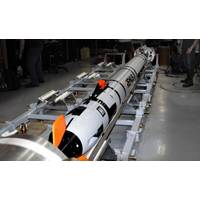
REMUS 620 UUV Validated for Torpedo Tube Deployment
A joint team from HII, Woods Hole Oceanographic Institution (WHOI), and U.S. Navy’s Naval Undersea Warfare Center Division Newport (NUWCDIVNPT) recently completed a milestone in advancing the U.S. Navy Submarine Force’s initiative to launch and recover autonomous undersea vehicles from submarine torpedo tubes.A test by the joint team confirmed the compatibility of the REMUS 620 with the SAFECAP, Virginia-class submarine weapons handling and torpedo tube systems, and other critical interfaces.HII’s next-generation medium uncrewed underwater vehicle (MUUV) fitted with WHOI’s
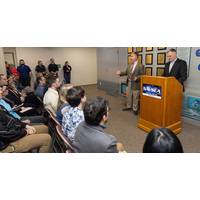
NUWC Division Newport Awards Recognize 12 Patent Inventors, Published Authors
The Naval Undersea Warfare Center (NUWC) Division Newport’s newest crop of inventors and authors were celebrated during a ceremony that recognized the latest patents and journal articles on May 30. The event capped a technical focus theme of “Innovation” held throughout May and coincided with National Inventors Month.Plaques featuring 12 patents and an equal number of peer-reviewed publications were on display as Chief Technology Officer Dr. Jason Gomez welcomed the audience.Gomez used the opportunity to announce the formation of Division Newport’s “Inventors Society”
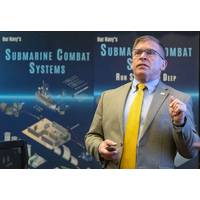
Executive Director of PEO UWS Stresses Importance of Submarines at NUWC Division Newport
During his visit to the Naval Undersea Warfare Center (NUWC) Division Newport on May 19, Executive Director Mike McClatchey, a member of the Senior Executive Service, Program Executive Office, Undersea Warfare Systems (PEO UWS), emphasized the critical role the submarine platform and warfare center play in safeguarding our country.“The submarine is our nation’s vanguard, and it is the most important platform to strategic deterrence,” McClatchey said. “The submarine force and the undersea domain are what makes our adversaries say, ‘not today.’ All those capabilities

 August 2025
August 2025




